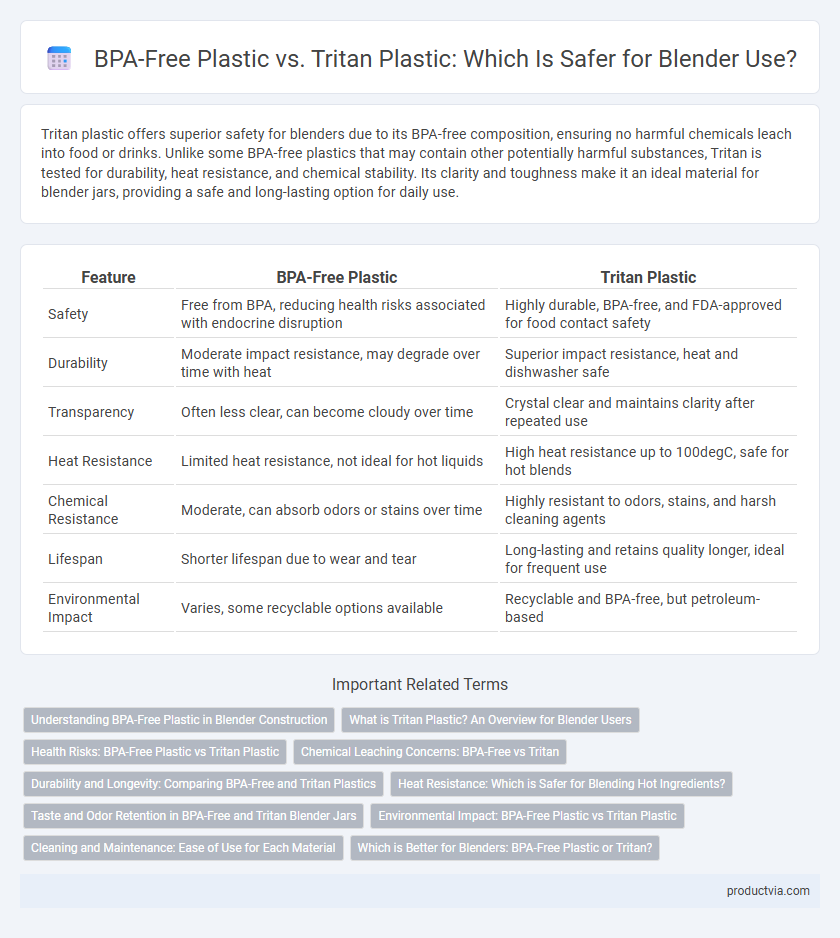Tritan plastic offers superior safety for blenders due to its BPA-free composition, ensuring no harmful chemicals leach into food or drinks. Unlike some BPA-free plastics that may contain other potentially harmful substances, Tritan is tested for durability, heat resistance, and chemical stability. Its clarity and toughness make it an ideal material for blender jars, providing a safe and long-lasting option for daily use.
Table of Comparison
| Feature | BPA-Free Plastic | Tritan Plastic |
|---|---|---|
| Safety | Free from BPA, reducing health risks associated with endocrine disruption | Highly durable, BPA-free, and FDA-approved for food contact safety |
| Durability | Moderate impact resistance, may degrade over time with heat | Superior impact resistance, heat and dishwasher safe |
| Transparency | Often less clear, can become cloudy over time | Crystal clear and maintains clarity after repeated use |
| Heat Resistance | Limited heat resistance, not ideal for hot liquids | High heat resistance up to 100degC, safe for hot blends |
| Chemical Resistance | Moderate, can absorb odors or stains over time | Highly resistant to odors, stains, and harsh cleaning agents |
| Lifespan | Shorter lifespan due to wear and tear | Long-lasting and retains quality longer, ideal for frequent use |
| Environmental Impact | Varies, some recyclable options available | Recyclable and BPA-free, but petroleum-based |
Understanding BPA-Free Plastic in Blender Construction
BPA-free plastic in blender construction ensures the absence of bisphenol A, a chemical linked to health risks, making it a safer choice for food preparation. Tritan plastic, often used as a BPA-free alternative, offers enhanced durability, impact resistance, and clarity while maintaining safety standards and resisting odors and stains. Understanding the benefits of BPA-free plastics like Tritan helps consumers make informed decisions about blender safety and long-term use.
What is Tritan Plastic? An Overview for Blender Users
Tritan plastic is a durable, BPA-free copolyester known for its resistance to impact, heat, and odors, making it a safe and practical choice for blender jars. Unlike typical BPA-free plastics that may still leach chemicals under high heat, Tritan maintains clarity and structural integrity while meeting FDA food safety standards. Blender users benefit from Tritan's shatter-resistant properties and its ability to withstand repeated blending cycles without degrading or affecting food flavor.
Health Risks: BPA-Free Plastic vs Tritan Plastic
BPA-free plastics eliminate bisphenol A, a harmful chemical linked to hormonal disruptions, making them safer options for blender containers. Tritan plastic, free from BPA and similar bisphenols, offers enhanced durability, clarity, and resistance to odors or stains, reducing potential health risks from plastic degradation. Choosing Tritan plastic for blender jars minimizes exposure to hazardous chemicals while ensuring longevity and food safety.
Chemical Leaching Concerns: BPA-Free vs Tritan
BPA-free plastics eliminate bisphenol A, a chemical linked to hormone disruption, reducing the risk of chemical leaching in blender containers. Tritan plastic offers enhanced durability and resistance to heat and impact while maintaining a non-BPA composition, further minimizing potential leaching of harmful substances during blending. Studies show Tritan's molecular structure provides superior chemical stability compared to standard BPA-free plastics, making it a safer choice for food contact applications.
Durability and Longevity: Comparing BPA-Free and Tritan Plastics
Tritan plastic offers superior durability and longevity compared to typical BPA-free plastics used in blender containers, resisting impacts and scratches more effectively. Its enhanced chemical stability ensures the material maintains clarity and structural integrity over time, even with frequent use and washing. BPA-free plastics may degrade faster under high temperatures and heavy use, potentially compromising safety and performance in the long term.
Heat Resistance: Which is Safer for Blending Hot Ingredients?
Tritan plastic offers superior heat resistance compared to BPA-free plastic, making it safer for blending hot ingredients without risk of warping or releasing harmful chemicals. BPA-free plastics, while free from bisphenol A, may still degrade under high temperatures, potentially compromising blender safety during hot blending. Choosing Tritan ensures durability and maintains safety standards when processing hot liquids in a blender.
Taste and Odor Retention in BPA-Free and Tritan Blender Jars
BPA-free plastic blender jars are crafted to minimize chemical leaching, resulting in lower odor retention and a more neutral taste profile during blending. Tritan plastic jars exhibit superior resistance to absorbing flavors and odors, maintaining blender jar freshness even after prolonged use with strong-smelling ingredients. This enhanced taste and odor retention in Tritan ensures consistent blending performance and avoids contamination between different recipes.
Environmental Impact: BPA-Free Plastic vs Tritan Plastic
BPA-free plastics are often chosen for blenders due to their reduced health risks and lower environmental persistence compared to conventional plastics containing BPA. Tritan plastic, a BPA-free copolyester, offers superior durability and recyclability, resulting in less frequent replacements and lower waste generation. The environmental impact of Tritan is minimized by its capacity for recycling and resistance to degradation, making it a more sustainable option for blender safety and eco-conscious consumers.
Cleaning and Maintenance: Ease of Use for Each Material
Tritan plastic stands out for its superior stain and odor resistance, making it easier to clean and maintain compared to BPA-free plastics which may retain residues over time. Its dishwasher-safe quality ensures hassle-free cleaning without risk of degradation, while BPA-free plastics often require manual cleaning to preserve their longevity and avoid surface wear. Tritan's durability against heat and chemicals allows consistent hygiene, crucial for blender safety and user convenience.
Which is Better for Blenders: BPA-Free Plastic or Tritan?
Tritan plastic offers superior durability and clarity compared to standard BPA-free plastics, making it a preferred choice for blender jars due to its resistance to stains, odors, and high temperatures. BPA-free plastics ensure safety by eliminating bisphenol A, a harmful chemical often found in older plastics, but they may lack the toughness and aesthetic appeal of Tritan. For blender safety and longevity, Tritan plastics provide a safer, more resilient material that maintains food quality without compromising health.
BPA-free plastic vs Tritan plastic for blender safety Infographic

 productvia.com
productvia.com